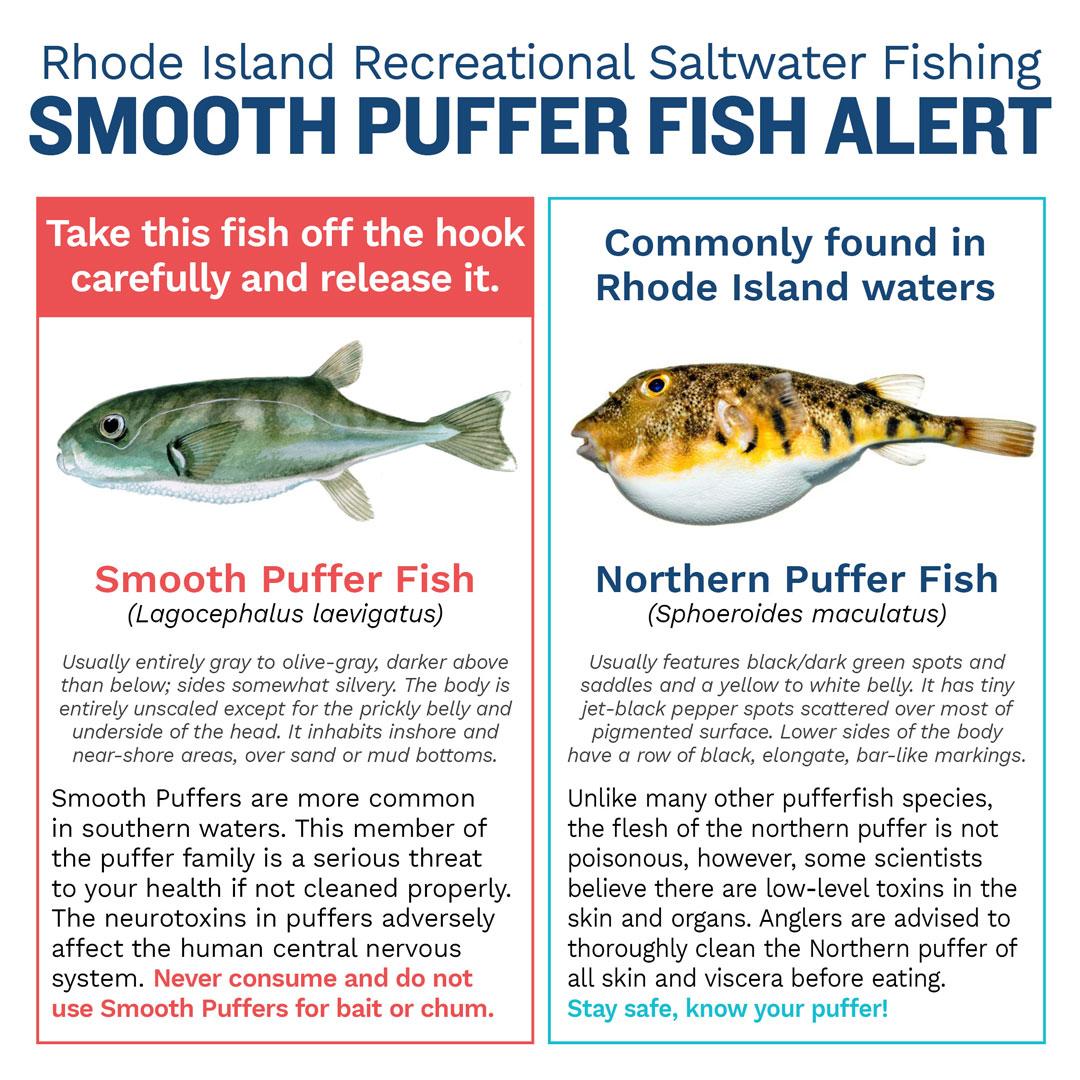A fisherman handles a northern puffer, which is native to the Northeast and safe to handle—and eat. Margaret Enloe / Chesapeake Bay Program
According to a story on Patch.com, Rhode Island anglers fishing inshore waters this summer are catching something deadly—toxic smooth pufferfish. If you’ve been paying attention to other news reports, you may have heard that ocean temperatures along much of the Atlantic Coast are far higher than normal. When this happens it’s not uncommon for wayward species usually reserved for southern and tropical waters to wander north. In fact, just recently a tarpon was landed on the beach at Cape Cod. For the most part, these rare catches in the Northeast are just a surprising treat for lucky anglers, but the smooth pufferfish might be a different story. Although New England is technically a part of the smooth puffer’s range, they are far more abundant in Southern waters, but not this summer.
From the article: Officials with the Rhode Island Department of Environmental Management said the fish seriously threaten people’s health if not cleaned properly. The neurotoxins in puffers responsible for illness and death are tetrodotoxin and saxitoxin, which adversely affect the human central nervous system. According to the U.S. Food and Drug Administration, these toxins are deadlier than cyanide and there are no known antidotes for these toxins. Also, these toxins cannot be frozen or cooked out.
Toxic Relationships

A PSA from Rhode Island explains the differences between the two puffers. RIDEM
In Japan, pufferfish are called fugu, and they are a true delicacy for the daring. Only the most highly skilled sushi chefs are allowed by law to clean them, and it’s been said that the best ones know how to prepare the fish while allowing the slightest amount of tetrodotoxin to lace the meat, which is reported to provide a slight numbing sensation. It’s also reported to be an aphrodisiac. All well and good, but it doesn’t take very much of this toxin to kill you. In some Caribbean cultures, powder made from dried pufferfish was also used in voodoo rituals to essentially turn people into zombies. (If you don’t believe me, check out the movie “The Serpent and the Rainbow.” It’s a cult classic.)
So, why are Rhode Island State officials so concerned? Who would be foolish enough to attempt eating one of these fish considering most people are at least peripherally aware of the danger of pufferfish? It’s a valid question, but it’s also fair to say that while most people know about toxic puffers, they don’t know about the northern pufferfish that can be found up and down the Eastern Seaboard. They look just similar enough to the smooth puffers that mistaken identify could occur, and while smooth puffers will end your life, northern puffers are safe to consume and shockingly delicious.
Northern pufferfish—sometimes called “blowfish”—have a devout cult following. When I was a little kid, we’d routinely catch them in crab traps in the bays of New Jersey. There are, however, many anglers that specifically target them with a rod and reel. Most puffers have very tiny mouths, and northerns are no exception. When they’re thick in the bays, you’ll see folks in small boats and lined up on public piers and bulkheads attempting to fill their coolers. All it takes is a bobber, split shot, tiny hook, and a single grass shrimp or piece of squid and you’re in. Because northern puffers are small, it takes a lot for a good meal, but if you hit them hard, you’re in for one of the best fish fries of your life.
Cleaning puffers is different than a filleting other fish, and this video (above) does a great job of showing you the steps. All their meat is in the tail, and, when cleaned properly, you end up with what almost looks like a chicken wing. Leaving the tail intact, you batter and fry these “wings” until golden brown, and the meat is incredibly sweet and mild.
Northern Puffer vs Toxic Smooth Puffer ID
While the organs of a northern puffer do not contain tetrodotoxin, biologists say there can be some in their skin, and levels can vary. Even if present, it’s still far milder of a dose than contained in tropical puffers like the smooth puffers, but it’s still recommended that all skin be thoroughly removed from a northern before cooking.
The smooth puffers, on the other hand, contain toxins in almost all parts of their body, including their skin. Therefore, Rhode Island officials are recommending that extreme care be taken even just to remove one from your hook. The key differentiating characteristics between smooth and northern puffers are that smooth puffers have more pronounced spikes on their bellies, and their backs are generally lighter in color than northern pufferfish. Until recently, if you caught a puffer in the Northeast, it would be pretty safe to assume it was an edible northern, but the bottom line is that if you’ve never eaten puffers before, this is not the summer to give it your first shot unless you are 100 percent certain you’re eating the right one.
The post One Bad Mother Puffer: Why Are Anglers Catching Toxic Pufferfish in Rhode Island? appeared first on Outdoor Life.
Articles may contain affiliate links which enable us to share in the revenue of any purchases made.
By: Joe Cermele
Title: One Bad Mother Puffer: Why Are Anglers Catching Toxic Pufferfish in Rhode Island?
Sourced From: www.outdoorlife.com/fishing/catching-toxic-pufferfish-northeast/
Published Date: Wed, 23 Aug 2023 14:35:08 +0000
----------------------------------------------
 Backyard GrillingWeekend WarriorsAdvice from DadBeard GroomingTV Shows for Guys4x4 Off-Road CarsMens FashionSports NewsAncient Archeology World NewsPrivacy PolicyTerms And Conditions
Backyard GrillingWeekend WarriorsAdvice from DadBeard GroomingTV Shows for Guys4x4 Off-Road CarsMens FashionSports NewsAncient Archeology World NewsPrivacy PolicyTerms And Conditions
